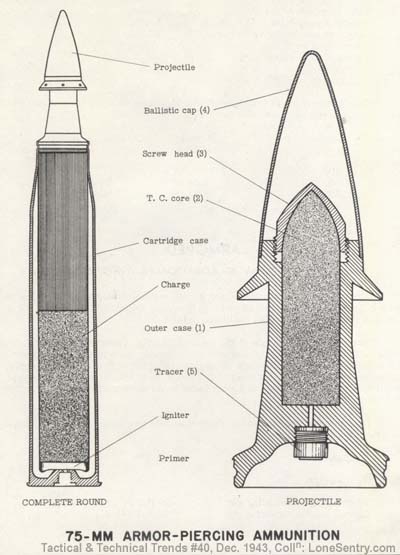The 75/55-mm AT Gun, Pak 41" from Tactical and Technical Trends
A U.S. intelligence report on German 75/55-mm tapered-bore antitank gun used in WWII, from [i]Tactical and Technical Trends[/i], No. 40, December 16, 1943.
[LEFT]THE 75/55-MM AT GUN, PAK 41[/LEFT]
An account of a new and powerful tapered-bore 75-mm AT gun made by the Rheinmetall factory, the 75/55-mm (2.95-in/2.17-in) Pak 41, has recently become available through Allied sources. The gun has a curious bore; the rear part is cylindrical and rifled; the central part, tapered and unrifled, and the muzzle section – 27.6 inches – cylindrical and unrifled. The weight of the powder charge fired is 95 per cent of the weight of the projectile. With an estimated velocity of approximately 4,000 f/s, and a penetration of 5.94 inches of homogeneous armor at 1,000 yards, the gun is most formidable.

a. General
The 75-mm Pak 41, one of the latest German antitank guns to be brought into service, is the third* of the Gerlich or tapered-bore weapons introduced. In issue No. 7, p. 3 of Tactical and Technical Trends, reference is made to the use of this principle in the 42-mm Pak 41. A 75-mm tank gun, the 7.5-cm Kw.K 41, is also known to exist, and it is very probable that this weapon too is of the tapered-bore variety. The caliber of the 7.5-cm Pak 41 at the breech is 75 millimeters (2.95 in), while at the muzzle it is reduced to 55 millimeters (2.17 in). The reinforced breech is of the vertical wedge type, and is semiautomatic. There is a muzzle brake. The weapon is very long, low and sturdy in appearance. The carriage which has a split trail, is unusual but extremely simple. The cradle is attached to the shield, which forms the basis of the carriage, by what is, in effect, a spherical universal joint. The cradle itself is cylindrical, and covers the whole of the rear half of the barrel. The gun is sighted up to 1,500 meters (1,635 yards), and the sight has four scales for use according to the actual muzzle velocity of the gun, which drops considerably owing to wear. The life of the barrel is provisionally estimated as 500 to 600 rounds.
The shield is composed of 2 1/4-inch plates bolted together with the barrel installed in a ball mount.
The elevating mechanism, of the sector type, is on the right-hand side of the cradle. The traversing mechanism is of the screw type and is on the left. There is no equilibrator. The buffer is hydraulic, and the recuperator is spring type. The wheels are metal with solid rubber tires. Traction is motorized. The axle is under-slung with torsion-bar suspension, which is automatically cut out when the trails are opened. Pneumatic brakes, controlled by the driver of the tractor, are fitted. .
Gun Data
Estimated muzzle velocity 4,123 Length of barrel (approx)170 inWeight in action1.4 tons (British long)Elevation-10° to +18°Traverse60° Height of axis of bore at 0° elevation34.6 inLength of recoil (approx)27.6 in
c. Ammunition
Fixed ammunition is used with an AP tracer projectile of Gerlich design (see accompanying sketch). The AP round is known as 7.5-cm Pzgr. Patr. 41 Pak 41 (Armor-piercing shell Model 41 for Pak 41).
The projectile consists of the outer case (1), the tungsten carbide core (2), the screw-head (3), the ballistic cap (4), and the tracer (5). The outer case has a forward and a rear skirt. Only the forward skirt is perforated. The screw-head is made of mild steel.

The propellant charge is diglycol tubular powder, while the igniter is of pyroxylin porous powder.
There is also an HE round (7.5-cm Sprgr. Patr) (HE shell Model 41 for Pak 41) as in the cases of the 2.8-mm s.Pz.B (antitank gun) 41 and the 4.2-cm Pak 41, but no details of this ammunition are known.
The following are brief specifications of the AP ammunition:
Total weight of round 16.65 lbTotal length of round 29.8 inWeight of projectile 5.68 lbWeight of tungsten carbide core 2.01 lbDiameter of core 1.16 inWeight of propellant charge 5.4 lb
d. Penetration
The following figures for penetration of homogeneous armor by this weapon firing the AP projectile have been estimated:
Range Thickness of armor in inches (yards) 500 (6.67 in) (5.75 in) 1,000 (5.94 in) (5.12 in) 1,500 (5.28 in) (4.49 in) 2,000 (4.63 in) (3.94 in)
It would be interesting to know how many of this were actually deployed.














